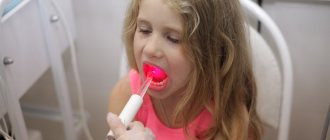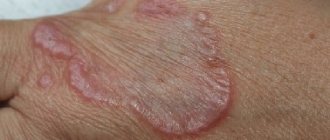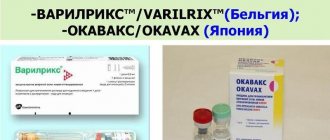Rhinitis, or, as it is more simply called, a runny nose, is an inflammation of the nasal mucosa, causing difficulty in breathing freely through the nose.
Author:
- Galkin Alexey Vladimirovich
ENT pathology expert
(Voted by: )
Rhinitis , or, as it is more simply called, a runny nose, is an inflammation of the nasal mucosa, which makes it difficult to breathe through the nose. The infectious process is characterized by copious mucous discharge from the nose, congestion, sneezing, a feeling of squeezing in the bridge of the nose, loss of smell, and headache. This is a common disease: it accounts for up to a third of all ENT diseases in childhood. Even a newborn can get rhinitis; the disease has no age restrictions.
With frequent episodes of recurrence of rhinitis, the child’s general, including psychological, health suffers, his performance at school decreases, and complications may arise (otitis media, sinusitis, bronchitis, etc.). It is important to prevent the disease from exacerbating and becoming chronic, so at the very beginning of the development of a runny nose, you should consult a pediatrician. There are several types of rhinitis. When making a diagnosis and prescribing treatment, one must proceed from the specifics of its course and the causes of its occurrence. Only a doctor can prescribe effective therapy that will quickly relieve the child of the disease, will not cause adverse reactions and will prevent frequent relapses.
Manifestations of acute rhinitis in newborns and infants
Acute rhinitis is especially unpleasant in the first months of life - in infants, the nasal passages are still very narrow, they do not know how to blow their nose on their own, because of this, it is difficult or impossible for the child to breathe through the nose, even with slight swelling of the mucous membrane. As a result, the process of feeding and sleep is disrupted. The child breathes frequently and shallowly through his mouth, is restless, his temperature rises, dacryocystitis (inflammation of the lacrimal sac) may develop, and weight loss may begin. Continuous breathing through the mouth, resulting from the inability to breathe through the nose, can cause loose stools and vomiting.
Principles of treating a runny nose
The main task of an otolaryngologist is to identify and eliminate the root cause that caused nasal breathing problems, as well as to relieve the symptoms of inflammation. Depending on the etiology of the disease, different treatment approaches are used:
- For rhinitis caused by allergen contact with the nasal mucosa, it is necessary to take antihistamines or topical corticosteroids, as well as completely eliminate the irritating factor.
- If the origin of the runny nose is viral, the child will be prescribed antiviral and immunomodulating drugs and rinsing the nasal cavity with antiseptic solutions.
- Bacterial rhinitis is eliminated with anti-inflammatory and antibacterial agents in the form of drops or sprays and, if necessary, taking antipyretics.
We remind parents that vasoconstrictor drops should be used no more than 2 times a day and no more than 5 days in total. Their abuse destroys the local immunity of the nasal cavity and turns a viral runny nose into a prolonged medicinal rhinitis, which is subsequently very difficult to cure.
In combination with drug treatment, physiotherapeutic procedures such as inhalations, ultraviolet irradiation and UHF therapy are successfully used. Taking multivitamins and walking in the fresh air will help strengthen your overall immunity and quickly restore nasal breathing.
Symptoms of acute rhinitis in older children
In older children, acute runny nose develops quickly. At first, a feeling of unpleasant burning, tickling, and itching in the nasal cavity is noticeable. Then frequent mucous discharge begins, sneezing, congestion, headaches, tearfulness, decreased perception of smells, a feeling of squeezing in the bridge of the nose, irritation on the skin under the nose.
Acute rhinitis has a rapid phase of progression - a decrease in general symptoms, stabilization of the condition occurs after about a week. However, this does not mean that during this period you should wait for independent recovery and not contact a pediatrician. Undertreated or ineffectively treated acute rhinitis can become chronic or cause complications.
Recommendations for the prevention of rhinitis
The main recommendation when acute rhinitis appears is not to let the disease take its course, immediately contact a pediatric ENT specialist to prevent complications. The best prevention against colds and infectious diseases is considered to be a set of measures, including strengthening the immune system, hardening, physical exercise, following the rules of general prevention, good nutrition and timely treatment when symptoms of the disease appear.
Symptoms of chronic rhinitis
- Catarrhal. Its symptoms are similar to acute rhinitis, but it occurs with less pronounced symptoms. It is characterized by constant mucus secretions, alternating sinus congestion, and frequent coughing.
- Vasomotor. It has specific symptoms: a runny nose appears in paroxysms, with periodic relief, sneezing, watery eyes, and headaches. During an attack of a runny nose, increased sweating, redness of the face, nervous tension, fever, and a feeling of numbness or tingling of the skin are noted.
- Hypertrophic. It manifests itself as difficulty breathing freely through the nose, pain in the head and sinuses, decreased sense of smell and hearing, changes in voice, high fatigue, which leads to problems with school performance.
- Atrophic. This is not the most common form in children. It manifests itself in the form of ozena (“fetid runny nose”) - discharge in the form of viscous mucus, dry nose, the appearance of crusts with an unpleasant odor, nosebleeds, difficulty in nasal breathing.
- Allergic. It occurs in response to the presence of an allergen and is accompanied by systematic repeated sneezing (in the form of attacks), liquid discharge, itching in the nasal cavity, decreased sense of smell, congestion, worsening at night.
The danger of a prolonged runny nose in a child
A persistent runny nose is a serious symptom that prevents you from getting a full night's sleep and often causes cough, headache and increased fatigue. It prevents you from concentrating on your studies, leads to anxiety and loss of appetite.
As a result of a prolonged runny nose, complications develop that are very dangerous for the child’s body:
- sleep and appetite disturbances;
- partial or complete loss of smell;
- Strong headache;
- snoring and snoring;
- sinusitis, including sinusitis;
- inflammation of the brain;
- frequent regurgitation and aspiration pneumonia in newborns;
- otitis;
- mastoiditis is a purulent inflammation of the mastoid process, in the area behind the ear.
Thus, a runny nose is not only an inflammation of the mucous membrane, but also a disease of the body as a whole. It is important to get rid of nasal discharge in the initial stages. If you miss the moment, more radical measures will be needed to eliminate the complications that have arisen. Often you have to resort to antibiotics, and in severe cases, surgery.
Why does rhinitis develop in children?
The nasal mucosa is the most important barrier preventing the penetration of pathogenic bacteria into the respiratory tract. In a healthy state, mucus envelops pathogens and removes them from the nose. But under negative conditions, for example, hypothermia, decreased immunity, increased concentration of harmful substances in the air, the protective function of the mucous membrane suffers and an inflammatory process can begin.
The following factors also contribute to a decrease in the protective function of the mucous membrane:
- deviated nasal septum;
- Immunity disorder or immune system disease;
- diathesis;
- adenoids and polyps;
- foreign body entering the nose and sinuses;
- long-term use of vasoconstrictor drugs.
Rhinitis can be either an independent disease or one of the symptoms of infections (influenza, whooping cough, measles, scarlet fever, meningococcus, diphtheria, etc.). Therefore, a medical approach to its diagnosis is needed.
Prognosis and prevention
With correctly prescribed therapy and following all the doctor’s recommendations, the inflammatory process is successfully cured.
To prevent nasal diseases, it is recommended to adhere to the following rules:
- eliminate or minimize exposure to harmful factors (tobacco smoke, etc.);
- treat ARVI in a timely manner;
- harden the child;
- maintain optimal temperature and humidity in the premises;
- provide adequate nutrition, sufficient physical activity, etc.
Doctors at the SM-Doctor clinic successfully diagnose and treat various types of runny nose in children, and also provide detailed recommendations for the prevention of relapses and complications.
Methods for diagnosing rhinitis in children
A pediatric otolaryngologist diagnoses and treats rhinitis in children. The diagnosis is made based on complaints from the child and parents, medical history, data from a nasal smear, rhinoscopy results, and blood tests to determine the state of immunity. Pharyngoscopy, endoscopic biopsy, radiography of the paranasal sinuses, and histological examination of a mucosal biopsy may be needed. For symptoms of allergic rhinitis, children are examined by an allergist-immunologist.
There are different types of runny nose: finding out the reasons
The main causes of runny nose in children are:
- viral infections (in 90% of cases);
- bacterial infections (attached in the later stages);
- allergens: plant pollen, animal hair, mold;
- a foreign body in the nasal cavity, this is an object that a child accidentally stuck into the nose;
- benign neoplasms in the nasal cavity, for example, polyps or cysts;
- excessive use of vasoconstrictor drugs leads to a prolonged runny nose.
Accordingly, depending on the etiology of the disease, the following types of rhinitis are distinguished:
- infectious (virus, bacteria);
- vasomotor (cold, chemical irritants);
- allergic (allergens);
- traumatic (trauma);
- medicinal (abuse of drops).
As you can see, there is no “ordinary” runny nose in nature. Only an ENT doctor can determine the cause of inflammation of the nasal mucosa and prescribe adequate treatment.
Treatment methods for rhinitis in children
Treatment of rhinitis in children is always complex and may include:
- Impact directly on the pathogen - the appointment of antibacterial and antiviral agents.
- Antiallergic therapy - used if rhinitis is of an allergic nature or in case of infectious-allergic inflammation.
- Treatment of symptoms: antipyretic, anti-inflammatory, antitussive drugs, inhalations, vasoconstrictor sprays or drops. Local vasoconstrictor drugs should not be used for more than a week, otherwise they are addictive and contribute to the development of drug-induced rhinitis. Vasoconstrictor drugs temporarily improve nasal breathing, but do not cure the disease itself. If the child does not yet know how to use nasal sprays himself, the doctor will teach the parents how to use them correctly.
- Physiotherapy: UHF, ultraphonophoresis, magnetic therapy, paraffin treatment, ultraviolet irradiation (quartz tube), laser treatment, endonasal electrophoresis.
- Surgical procedures: resection of a deviated septum, removal of adenoids, polyps, cryodestruction of the mucous membrane, etc.
- Homeopathic remedies.
- Massage of bioactive points of the head.
Typically, treatment of rhinitis in children is carried out on an outpatient basis. Hospitalization is carried out:
- at high temperature;
- with hemorrhagic syndrome;
- at the onset of complications;
- with severe respiratory failure;
- in case of illness in a newborn.
How to alleviate the condition of a child’s body with a runny nose?
A severe runny nose and nasal congestion in a child not only interferes with the baby’s breathing, but also with eating, speaking, and sleeping. Adults can alleviate the child’s condition using simple methods:
- Maintaining optimal temperature and humidity levels in the room. The temperature should vary from 18 to 22 degrees, but lower is better than higher. Humidity, on the contrary, should be relatively high: 50-70%. You can increase its level by regularly carrying out wet cleaning or using air humidification methods - spraying, artificial humidifiers.
Proper nose blowing is important. “Sniffing” your nose provokes infection to enter deeper into the nasopharynx. You should not blow your nose through both nostrils at the same time - this can cause otitis media. Each nostril is blown separately, while the other is covered.- Experts advise using disposable paper handkerchiefs, since bacteria easily multiply in the damp environment of a fabric handkerchief.
- For young children, secretions are removed using an aspirator. This procedure must be carried out very carefully so as not to damage the delicate mucous membrane of the nasal passages.
- Rinsing the nose with saline solutions. To do this, you will need a solution with sea salt, for example, Sialor Aqua. The healing properties of sea water are based on its affinity with the intercellular fluid in the human body. Microelements and salts found in sea water have an anti-inflammatory and antiseptic effect, improve metabolic processes in tissues and help restore the protective properties of the mucous membrane. Saline irrigation of the nose is recommended as a preventive measure for colds. To avoid frequent colds, it is enough to rinse your nose with sea water several times a week.
- Elimination of swelling of the mucous membrane. To do this, it is necessary to select an effective vasoconstrictor drug. One of the best is Sialor Reno. Its main active ingredient, oxymetazoline, will quickly relieve nasal congestion and ease the child’s breathing.
- Allergic runny nose. The therapeutic regimen is selected individually and exclusively by the doctor. Self-medication can lead to tragic consequences! First, the specialist will determine the source of the allergy, then prescribe antihistamines. The task of parents is to exclude the child from contact with allergens and regularly carry out wet cleaning of the room.
All of the above methods are designed to soften the course of the disease and eliminate some unpleasant symptoms. Now let’s look at what you shouldn’t do when a child has a runny nose, and what methods are recommended by modern medicine.
How does vasomotor rhinitis occur?
The main factors and causes contributing to the appearance of vasomotor rhinitis are as follows:
- Vegetative-vascular dystonia;
- Infectious diseases suffered by the child (influenza, mumps, chicken pox, rubella, etc.);
- Stress;
- Endocrine disorders, genetic predisposition;
- Congenital/acquired nasal septum defects;
- Adenoids;
- Incorrect gastronomic habits (predominance of spicy, salty foods in the diet);
- Autoimmune processes in the body;
- Hypothermia, mechanical injuries.
There are plenty of factors that provoke the development of the disease. The child fell, hit his nose, and started bleeding. After this, a moderate or mild inflammatory process of the mucous membrane necessarily occurs. This whole story easily provokes the development of vascular changes.
In this case, vasomotor rhinitis in a child may not be detected immediately after the influence of the provoking factor. Such diseases develop unnoticed and may not progress for weeks, even months. Not all parents immediately distinguish rhinitis from a simple runny nose or idle “sniffing” of the baby’s nose. Only when vasomotor rhinitis begins to cause serious trouble and their beloved child continues to complain about certain symptoms, do mothers and fathers understand that a good ENT doctor is needed.






